Sequencer Page
The Sequencer page of VALVES enables you to edit and sequence the instrument's intricate articulations in depth.
The Sequencer page is where you edit the articulation sequences in use by each of the five instruments. It has the following elements:
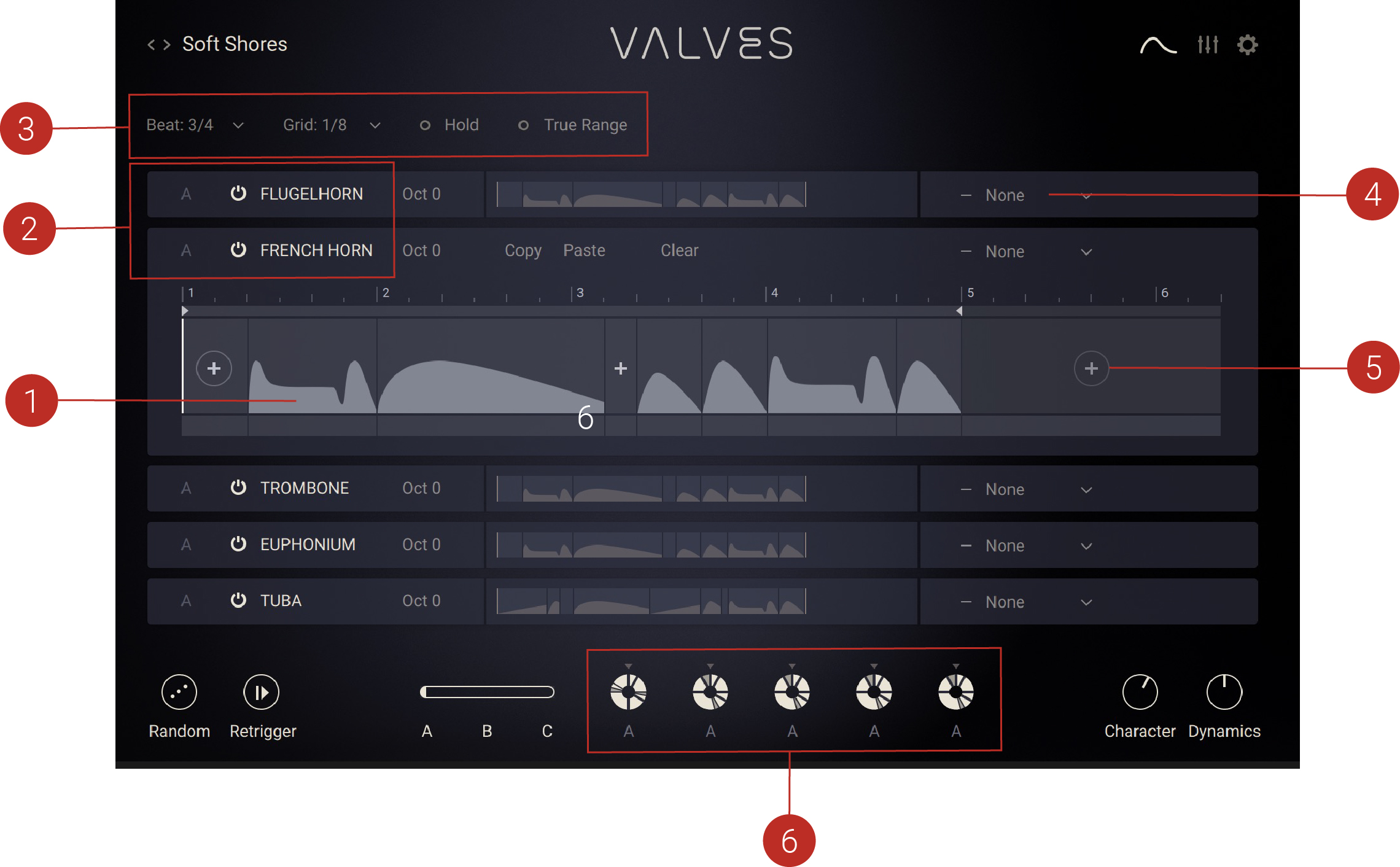
Articulation Sequencer: Displays the instrument's articulations, which can be viewed and edited here.
Instruments: Lists the five instruments in descended order of pitch.. Click on any track to expand it. Only one track can be expanded at once.
Global Controls Section: Controls the time base, grid, Hold and note range settings.
Voice Alternates: Selects which instrument, if any, will alternate its note playback with this track.
Add Articulation: Opens the Articulations. For more information, refer to Articulations.
Sequencer Tracks Overview: Provides a quick overview of the sequence playing back in each instrument, available from any page in VALVES.
Global Controls
The Sequencer section has a number of controls that affect all five of the instruments' sequencers and the behaviour of each of the instruments.
 |
Beat: Sets the time signature for the sequencers. This can be set to 4/4, 3/4 or 6/8 time.
Grid: Sets the snap behaviour of the sequencers' grids. This can be set to 1/4, 1/4 triplet, 1/8, 1/8 triplet or 1/16th of a bar. It determines the snap behaviour of the left and right loop markers in a sequencer and also how blocks of articulation data in the sequencer snap to divisions of bar markers.
Hold: Normally, releasing a note will cause sound to stop playing. The Hold control, when activated, acts like a sustain pedal and will continue any active sequence and play it in a loop until Hold is deactivated. If you play a different note while Hold is activated the sequencer will wait until it encounters the next active block of articulation data before sounding the new note. By default the Hold control is tied to the sustain pedal.
True Range: Each of the five instruments in VALVES has a natural range, a lowest and highest note beyond which it is not possible to play. By default, VALVES lets you play all the instruments across the full range of keys. If however you activate the True Range control, the key range becomes limited to the real ranges of the active instruments. This is reflected by the blue key overlay on Kontakt's keyboard shrinking to show only the real key range available. Notes that you play outside of this range will not sound. The total key range available reflects the number of instruments that are activated so if you turn off the tuba for example you will see the lower end of the key range becomes unavailable. Similarly turning off the flugelhorn will remove some notes from the top end of the key range.
Track Overview
Each instrument's sequencer track can be expanded by clicking on it. Only one track can be shown in expanded view at any one time. Each track has an identical set of controls.
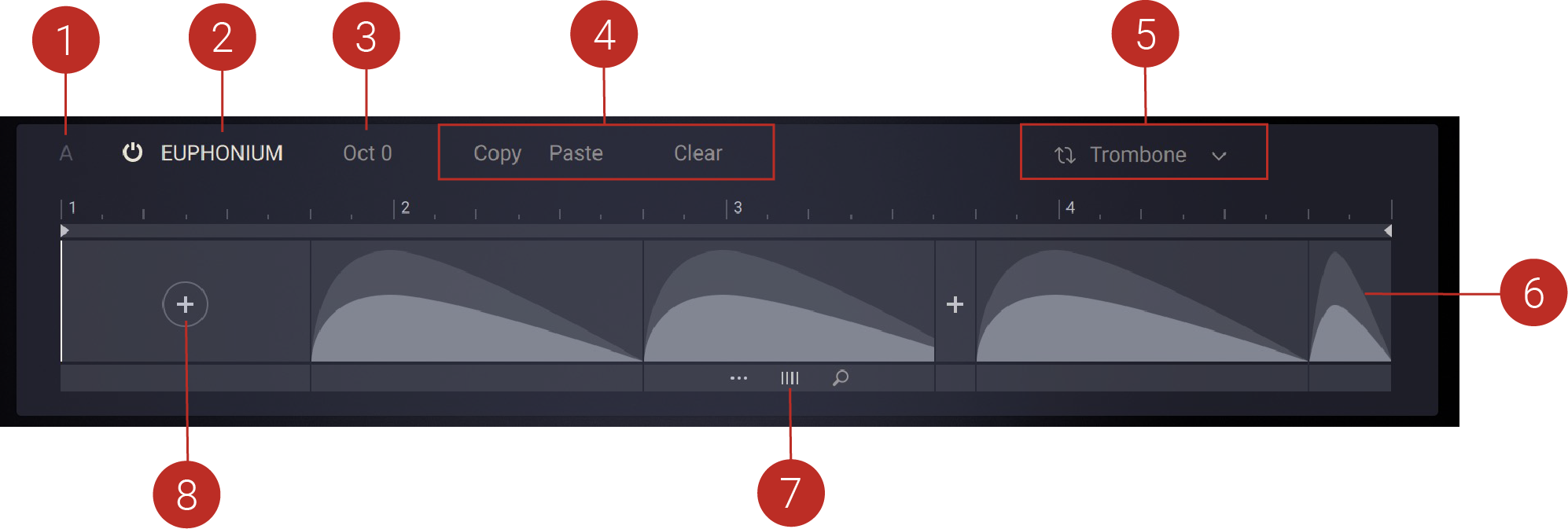
Moment: Shows which sequencer Moment, A, B or C the track is using.
Instrument On/Off and Name: Identify the instrument and activate or deactivate it.
Octave control: Tunes the instrument up or down. Drag the mouse up or down to tune the instrument + or - 2 octaves.
Copy, Paste and Clear Sequencer: Copies a sequencer lane's articulations and pastes them into another instrument's lane. Clear removes all data from the sequencer lane.
Voice Alternate / Arpeggiator: Selects an instrument with which this instrument will alternate its pitch during playback.
Articulation Sequencer: Manages how notes are performed using different playing styles.
Sequencer Operations: Delete an articulation block, Repeat to fill the whole sequencer with a block. Use the middle handle to drag blocks left or right. The magnifying glass icon opens the articulation browser and lets you choose new articulations for playback.
Add New Articulation: Opens the Articulations. For more information, refer to Articulations.Opens the Articulations.
Editing Tracks
Each of the five instruments in VALVES has its own sequencer track that contains articulations. The sequencer track for each instrument can be edited to change the way it plays back its articulations.
To choose a resolution for the sequencers, use the Beat menu at the top left of the Sequencer to set the pattern to 4/4, 3/4 or 6/8 resolution.
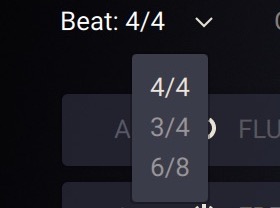
To set the snap value for the sequencers' grid, use the Grid menu.
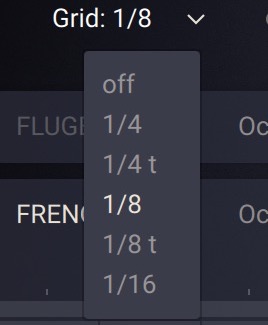
To clear an entire sequencer lane, click the Clear button at the top of the sequencer.
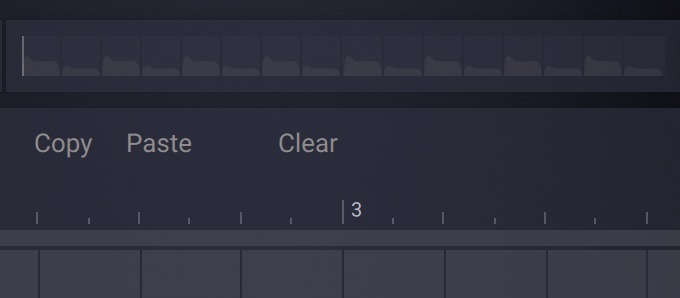
To clear an individual block, click the Delete command accessible from the lower part of an articulation block.
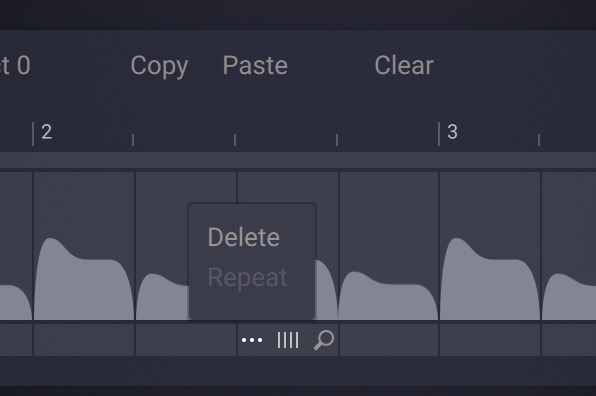
To add an articulation to an empty block, click on the + icon to open the Articulation browser. For more information, refer to Articulations.
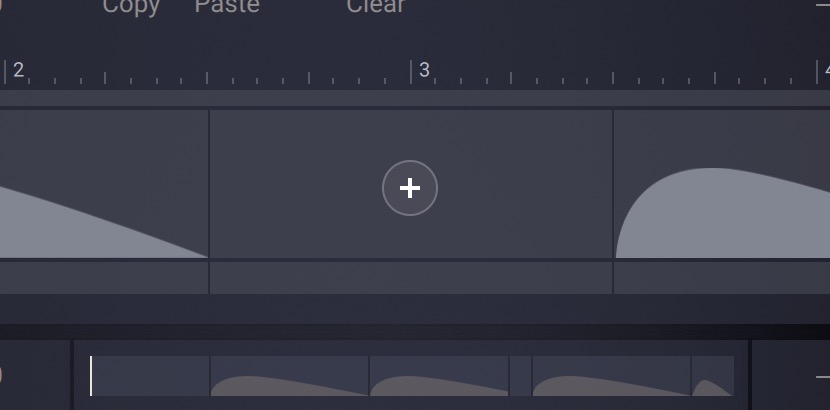
Tip
A Sequencer does not have to be filled with articulations. An empty block or area simply means no notes will sound at those points.
Locators
The left and right locators govern the length of the loop for a Sequencer track. By moving these around you can set any Sequencer to play a part of the loop rather than the entire loop. This makes VALVES polymetric, since different instruments can play different length loops as part of the same preset. The blocks of articulation data and the locators will snap to a beat grid based on the setting you make in the Grid menu at the top of the Sequencer.
Move the mouse over the left or right edge of any articulation block and drag it to be longer or shorter.
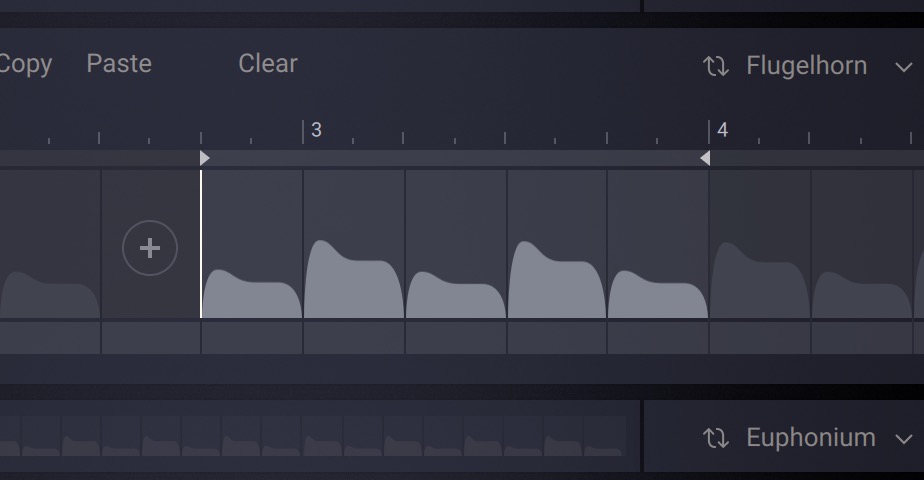
You cannot overlap one block with another so the dragging will stop as soon as it meets another block. Dragging obeys the Beat and Grid settings made in the menus at the top of the Sequencer and these apply to all five sequencers.
Tip
If you hold the ALT key on your keyboard while dragging the left or right markers in the Sequencer you can temporarily disable snapping, meaning they will no longer snap to beat or bar markers.
Edit Buttons
The edit buttons give you access to additional edit functions as well as the Articulation Browser, which lets you select an Articulation for the corresponding block.
Move the mouse over the lower or central part of any articulation block to reveal its edit buttons.
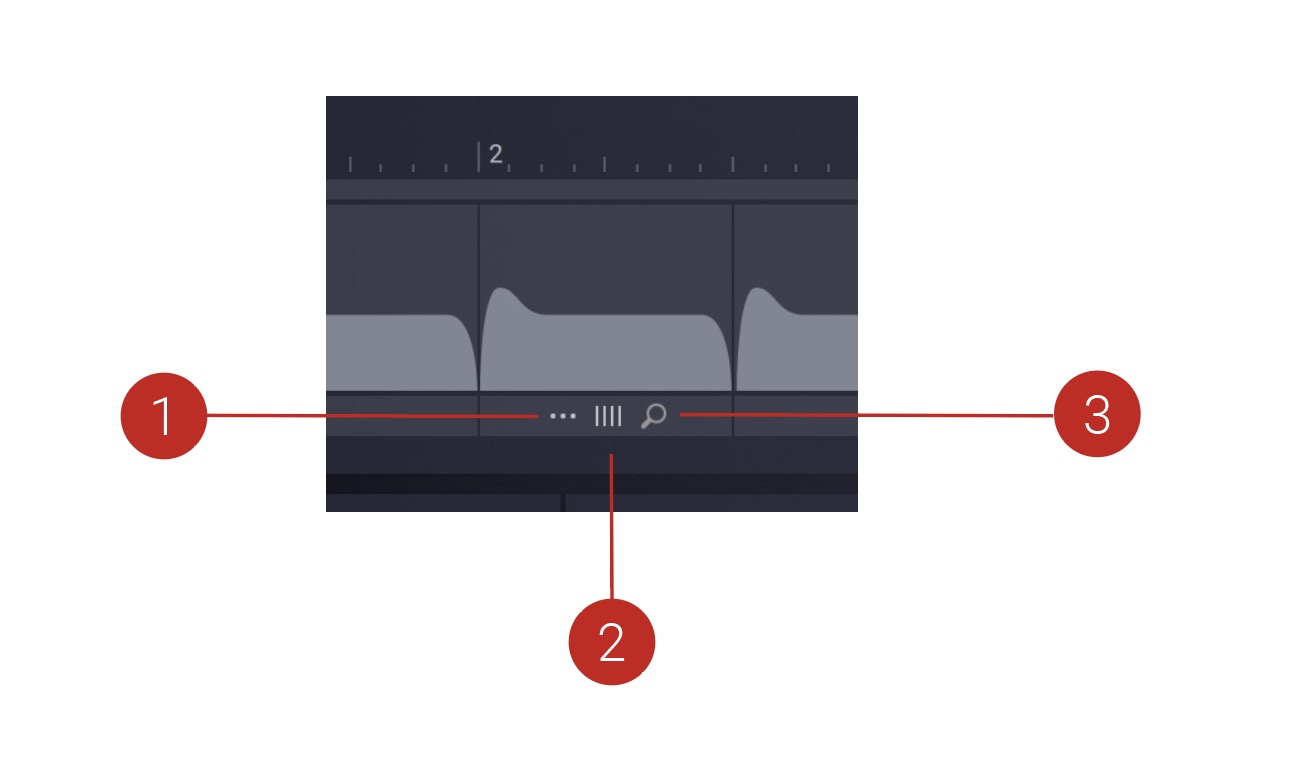 |
The button showing three dots, when clicked, opens a menu that allows you to delete or repeat the current block. Note that when there is insufficient space to repeat the block in the sequencer, the Repeat option will be unavailable.
The button showing four solid lines allows you to pick up the articulation and slide it left or right to alter its placement in the sequencer.
The magnifying glass button will open the Articulation Browser. For more information, refer to Articulations.
Articulations
Articulations are musical parameters that determine how notes are performed. They determine a note's timbre, dynamics and pitch. In VALVES, all the articulations are created using meticulously sampled performances by real musicians. This includes multiple velocity layers as well as polyphonic legato for sustain articulations and true legato sustain transitions.
In VALVES your MIDI playing is translated into authentic and dynamic-sounding realistic brass performances because simple note input is translated into more complex playing styles as a real brass player would play them. Any Sequencer in VALVES can play back multiple articulations from the selection available, making for dynamic and musical results.
For any instrument's sequencer you can select from seven main types of articulation and from each type, a number of variations. The main articulation categories are:
Essential
Crescendo
Decrescendo
Swell
Waves
Noises
Motives
Essential
Essential articulations are commonly used and can form the basis for a huge variety of different expressions.
 |
Sustain: The sustain articulation provides long held sustaining notes with a medium attack. This articulation also includes variations for extended realism:
Auto tonguing: If a sustained note is held for a very long time (5-6 sec) a new sustain sample with a different attack (created by a short movement of the player's tongue) is automatically triggered. This captures the effect of a brass player quickly breathing in.
Manual tonguing: Two consecutive sustain blocks at the same pitch will also provide the tonguing effect.
Two consecutive sustain blocks at a different pitch (due to input chord changes or settings in the voice alternate section) provide true legato samples. These samples connect the different pitches via sampled performances of the instruments' intervals, resulting in a realistic transition from one note pitch to the next.
Staccato: An articulation technique characterised by a fast attack and a very short decay, resulting in a detached percussive sound.
Marcato Med: This articulation is similar to Staccato but provides a softer attack with a longer decay.
Crescendo
Crescendo articulations build slowly to a peak and then diminish quickly.
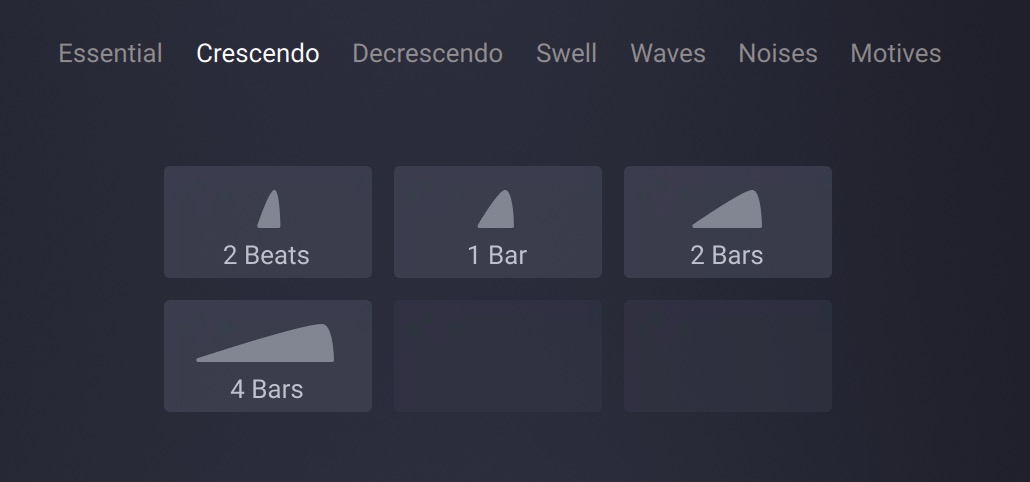 |
2 Beats: Gradually increases loudness over time. This articulation has a length of two beats and syncs its tempo with your host.
1 Bar: Gradually increases loudness over time. This articulation has a length of one beat and syncs its tempo with your host.
2 Bars: Gradually increases loudness over time. This articulation has a length of two bars and syncs its tempo with your host.
4 Bars: Gradually increases loudness over time. This articulation has a length of four bars and syncs its tempo with your host.
Decrescendo
Decrescendo articulations build quickly to a peak and then diminish more slowly.
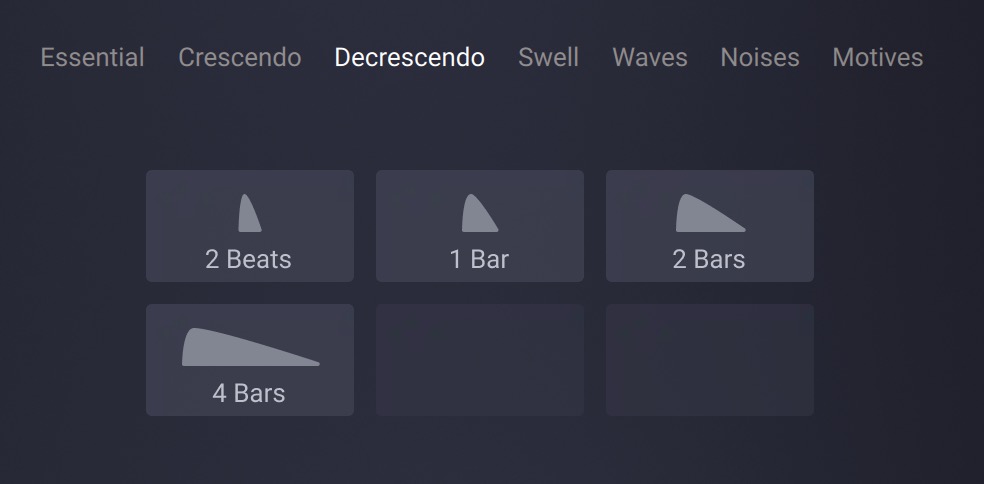 |
2 Beats: Gradually decreases loudness over time. This articulation has a length of two beats and syncs its tempo with your host.
1 Bar: Gradually decreases loudness over time. This articulation has a length of one bar and syncs its tempo with your host.
2 Bars: Gradually decreases loudness over time. This articulation has a length of two bars and syncs its tempo with your host.
4 Bars: Gradually decreases loudness over time. This articulation has a length of four bars and syncs its tempo with your host.
Swell
Swell articulations build to a peak and then diminish over time.
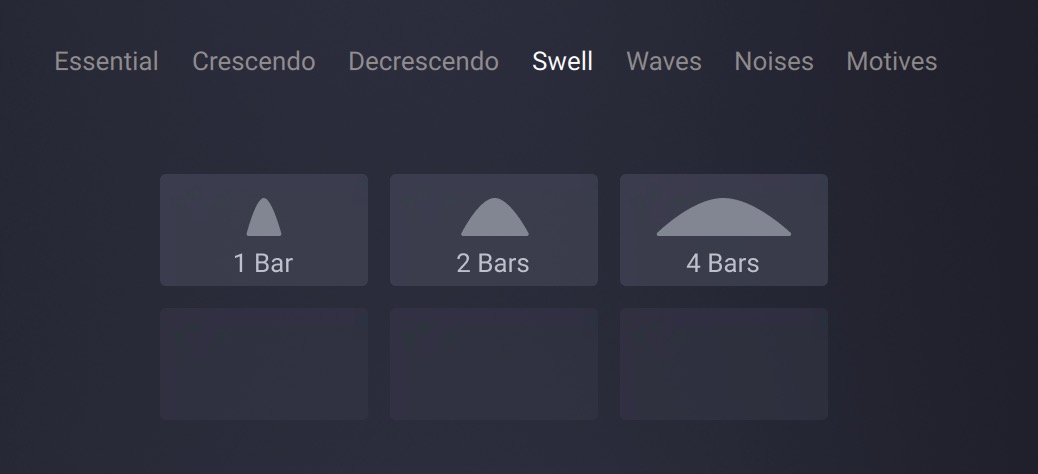 |
1 Bar: Gradually increases and decreases loudness over time. This articulation has a length of one bar and syncs its tempo with your host.
2 Bars: Gradually increases and decreases loudness over time. This articulation has a length of two bars and syncs its tempo with your host.
4 Bars: Gradually increases and decreases loudness over time. This articulation has a length of four bars and syncs its tempo with your host.
Waves
Waves are unique, long and dynamic rhythmic articulations.
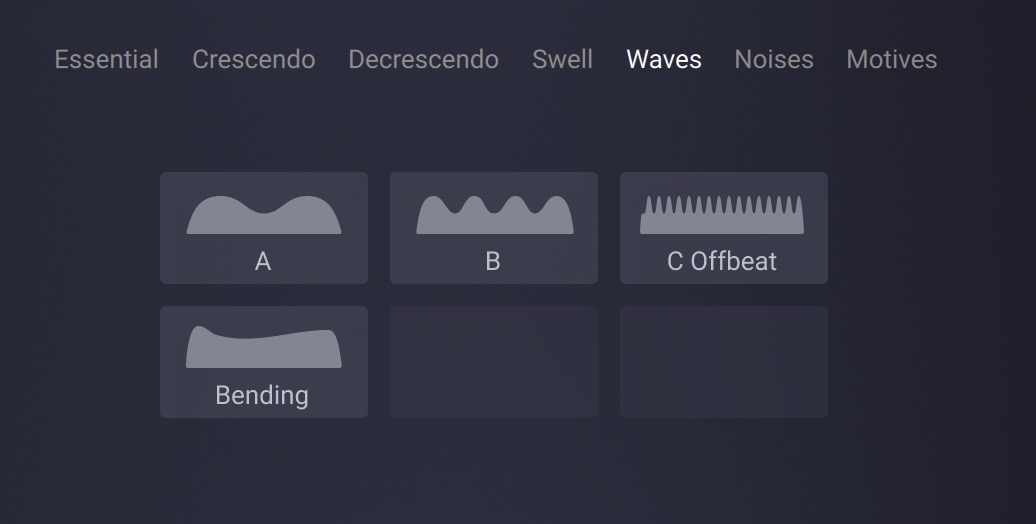 |
Waves A: A 4 bar long, a two time slow increase and decrease in volume. Creates a slow evolving texture. This articulation syncs its tempo with your host.
Waves B: A 4 bar long, a four time increase and decrease in volume. Creates an evolving rhythmical texture. This articulation syncs its tempo with your host.
Waves C: A 4 bar long, an off beat increase and decrease in volume. Creates a rhythmical texture similar to effects created via side chain compression. However, the waves are actually performed and produce an authentic acoustic brass texture. This articulation syncs its tempo with your host.
Bending: A long sustaining note with performed pitch deviation. Bending provides a unique and expressive pitch texture.
Noises
Noise articulations capture non-pitch noises and effects performed on brass instruments.
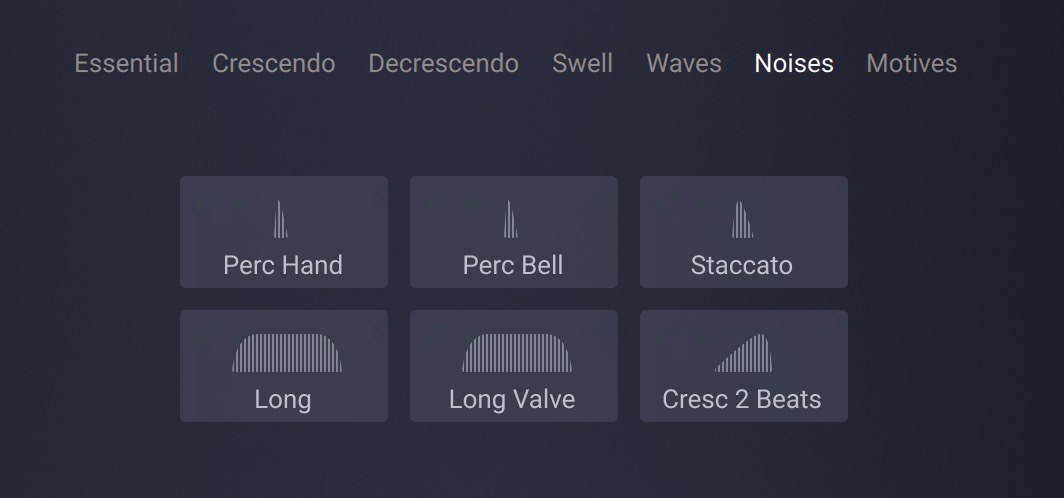 |
Perc Hand: A percussive sound created by hitting the mouthpiece of the instrument with the hand.
Perc Bell: A percussive sound created by hitting the bell of the instrument with the fingers.
Staccato: A short air flow through the instrument. Similar to the Staccato articulation but without pitch.
Long: A long air flow through the instrument. Similar to the Sustain articulation but without pitch.
Long Valve: A long air flow through the instrument with additional percussive elements from the movements of the instrument valves.
Cresc 2 Beats: An articulation that gradually increases the loudness of air flow noise over time. This articulation has a length of two beats and syncs its tempo with your host.
Motives
Motives articulations add specific rhythmic gestures to the sequence.
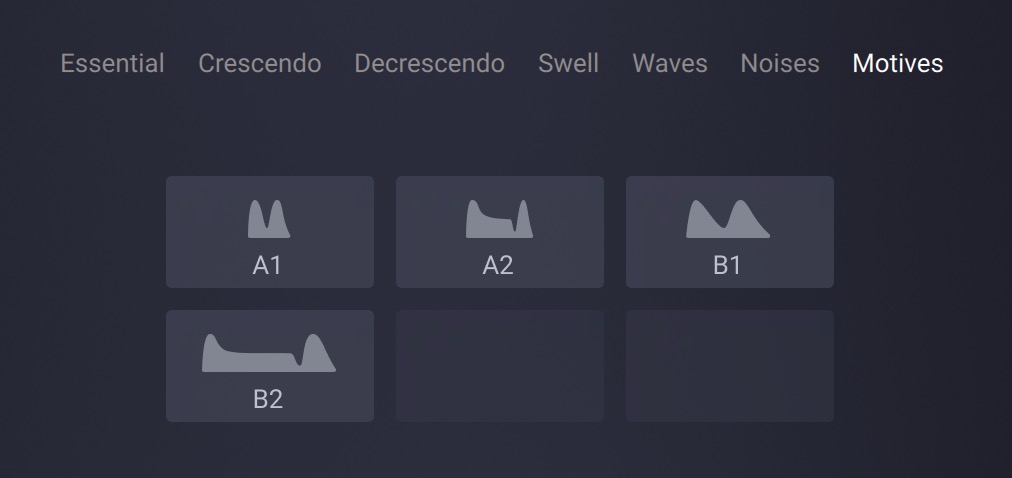 |
A1: Two 16th notes performed as a rhythmical element. This articulation syncs its tempo with your host.
A2: A dotted 8th note followed by a 16th note performed as a rhythmical element. This articulation syncs its tempo with your host.
A3: Two 8th notes performed as a rhythmical element. This articulation syncs its tempo with your host.
A4: A dotted 4th note followed by an 8th note performed as a rhythmical element. This articulation syncs its tempo with your host.